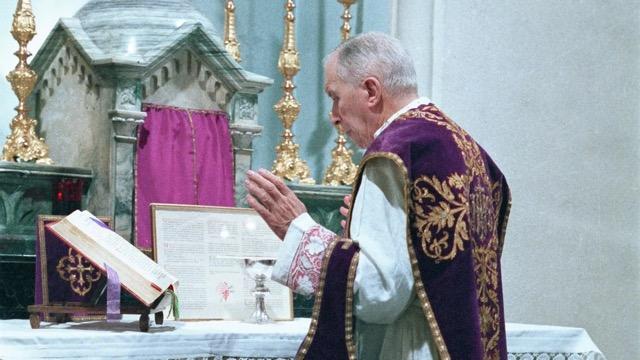by Grok AI and Xavier Calmet
The Beauty of the Traditional Latin Mass

In an age of ceaseless noise and fleeting distractions, the Traditional Latin Mass—often called the Tridentine Mass or the Extraordinary Form—stands as a timeless sanctuary of reverence, mystery, and profound beauty. Rooted in the ancient rites of the Roman Church, codified at the Council of Trent in the 16th century, and celebrated unchanged for centuries until the reforms of Vatican II, this liturgy invites the faithful into a sacred encounter with the divine. Its beauty lies not in novelty or accessibility alone, but in its ability to elevate the soul, transcend the ordinary, and draw us closer to the eternal truths of our faith. As Pope Benedict XVI affirmed in his 2007 motu proprio Summorum Pontificum, this form of the Mass is a treasure of the Church, expressing the same lex orandi (law of prayer) as the newer rite but in a manner enriched by centuries of organic development.
The aesthetic splendor of the Traditional Latin Mass begins with its language: Latin, the tongue of the ancient Romans and the universal language of the Western Church for over a millennium. Far from being a barrier, Latin serves as a bridge to the sacred. It is unchanging, precise, and poetic, shielding the liturgy from the whims of cultural fads or regional dialects. When the priest intones "Introibo ad altare Dei" ("I will go unto the altar of God"), the words echo the psalms of David and the prayers of saints across ages. This linguistic continuity fosters a sense of catholicity—universality—that unites worshippers from every nation. In a fragmented world, where English alone might divide by accent or idiom, Latin whispers a shared heritage, reminding us that the Mass is not a local event but a participation in the heavenly banquet described in Revelation.
Visually and aurally, the Mass unfolds like a masterpiece of sacred art. The priest, facing ad orientem (towards the east, symbolising Christ the rising Sun), leads the congregation in a unified gaze toward God rather than toward each other. This orientation is no mere tradition; it embodies the sacrificial nature of the Eucharist, where the priest acts in persona Christi, offering the unbloody sacrifice of Calvary anew. The elaborate vestments—chasuble, maniple, and biretta—evoke the splendour of the Old Testament priesthood, adorned as if for a royal court. Gregorian chant, the Church's official music, fills the air with melodies that ascend like incense, free from the rhythms of popular song. Polyphony may interweave, creating a sonic tapestry that lifts the heart heavenward. Silence, too, plays its role: profound pauses after the Consecration allow the mystery of transubstantiation to resonate in the soul, unhurried by acclamations.
At the heart of this beauty is the Mass's profound theology, expressed through ritual precision. Every gesture—the sign of the cross repeated 52 times, the genuflections, the kissing of the altar—carries symbolic weight, teaching catechism without words. The Canon of the Mass, whispered inaudibly by the priest, veils the most sacred moments in awe, inviting contemplation rather than spectacle. This "mystery of faith" is not obscured but heightened,

drawing us into the apophatic tradition of knowing God through what He is not. As St. Thomas Aquinas taught, the Eucharist is the source and summit of Christian life; in the Traditional form, its sacrificial essence shines clearly, undistorted by innovations that might emphasise community over communion with the divine.
The fruits of this liturgy are evident in the lives it has shaped. Saints like Thérèse of
Lisieux and Padre Pio drew spiritual nourishment from its depths, finding in its rigour a path to holiness. Those who attend the Traditional Mass often speak of a deepened prayer life, a greater sense of the supernatural, and a detachment from worldly concerns. It challenges us to prepare—through fasting, confession, and study—rather than arriving casually. Yet this demands nothing less than what Christ asks: "Take up your cross and follow me." Critics may argue that Latin excludes the uninitiated or that the rite feels
distant. But beauty, true beauty, often requires effort to apprehend.
Just as one studies Shakespeare to savour his sonnets or trains the ear for Bach's fugues, so the Traditional Mass rewards the seeker. Missals with side-by-side translations make it accessible, and its universality means a traveller in Tokyo or Rome can join seamlessly. Pope St. Pius V, in standardising the Missal in 1570, preserved this rite against Protestant simplifications, ensuring the Church's worship remained a bulwark of orthodoxy.
Ultimately, the beauty of the Traditional Latin Mass is the beauty of Christ Himself—veiled in humility yet radiant in glory. It calls us to worship in spirit and truth, where earth touches heaven. In our Parish Proclaimer Magazine, let us celebrate this gift, inviting all to experience its transformative power. May it inspire us to live the Mass beyond the pews, offering our lives as a pleasing sacrifice to God.

